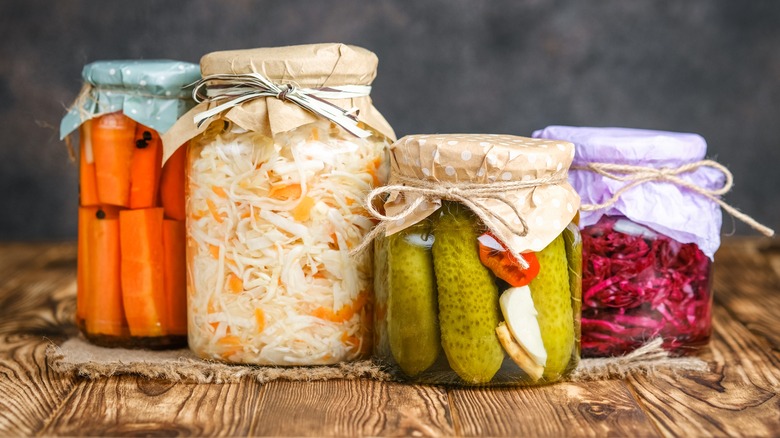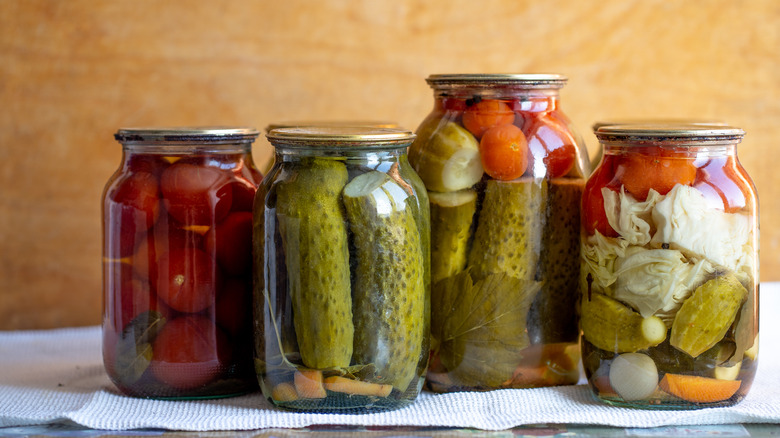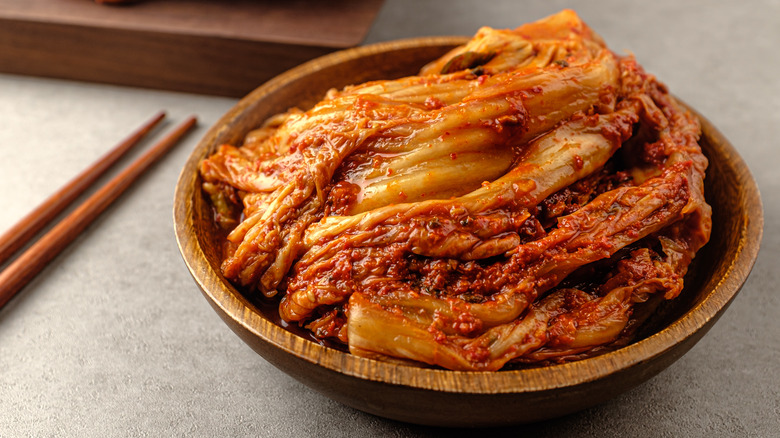Fermented Vs. Pickled Foods: What's The Difference?
Food preservation has always presented challenges, and in the days before refrigerators, people had to get creative to avoid spoilage. The National Center for Home Food Preservation notes that early methods relied on the climate, as those in cold regions could refrigerate or even freeze their harvest, while those in hot climates could sun dry their food. High in the Andes, the Incas even found a way to naturally freeze-dry potatoes, making a foodstuff called chuño that could last for years. Of course, these methods left people at the mercy of the weather, and it would take another level of ingenuity to preserve foods in the home.
Nowadays, canning is probably the most accessible means of food preservation. However, the hermetically-sealed jars that make home canning possible weren't invented until 1958. Before that, people were far more likely to pickle or ferment their foods to ward off mold and bacteria. And though now we have ways of preserving food that don't impart added flavors, pickling and fermenting are excellent skills for cooks who want to take their culinary knowledge to the next level. Asia Society notes that pickled and fermented foods are similar in some ways — they both have long staying power and give the foods a signature tang — but the science behind them is quite different.
Pickled foods
Pickling preserves food by completely submerging it in an acidic liquid, typically vinegar. According to the National Center for Home Food Preservation, pickling is an ancient process that dates back as far as the Roman Empire, as we know Romans made a type of pickled fish sauce they called garum. On a chemical level, HowStuffWorks explains that bacteria cannot survive in an environment that is as powerfully acidic like a vinegar solution. However, Food & Wine notes that vinegar kills bacteria in, not just in the solution but latent microorganisms in the food itself. The reason foods decay is because the organisms that inhabit the food produce enzymes that break them down. So, pickling does not totally prevent food from decaying, it just stays the process.
The most popular food to pickle is the cucumber, which is so beloved that in much of the world, the word "pickle" will almost always be used to refer to pickled cucumbers. However, you can pickle just about any vegetable you want. Other favorites include pickled onions, pickled jalapeños, as well as pickled veggie medleys like Italian Giardineire. While it's more common to pickle vegetables, you can also find pickled eggs and the Scandinavian classic, pickled herring.
Fermented foods
The use of fermentation for food preservation dates back even further than pickling. The National Center for Home Food Preservation suggests that fermentation was accidentally discovered when barley grains were left in the rain, exposing them to microorganisms that converted the starches to sugars, and the sugars to alcohol — creating the first beer. Anthropologists believe this could have happened as early as 10,000 B.C. Fermented foods have an acidic flavor, much like pickled foods, but that acid does not come from a vinegar bath. Instead, Lab Manager explains that fermented foods get their acidic taste from natural bacteria. It seems a little backward, considering preservation is supposed to protect food from microorganisms, but certain kinds of bacteria, known as probiotics, are useful in this regard and are also good for gut flora. As Asia Society explains, probiotics convert sugar and carbohydrates into acid, carbon dioxide, and alcohol, which help to preserve food.
Fermented foods come in a much wider variety than pickled foods. Healthline offers several examples of fermented foods, including yogurt, kimchi, miso, kombucha, and tempeh. Serious Eats also explains that fermentation is the key to making a sourdough bread base and the source of the tangy taste for which such loaves are named. So the essential difference between pickling and fermenting is that pickling involves adding food to an acid like vinegar, while fermentation uses chemical reactions between the sugars and natural bacteria to preserve and sour food.


